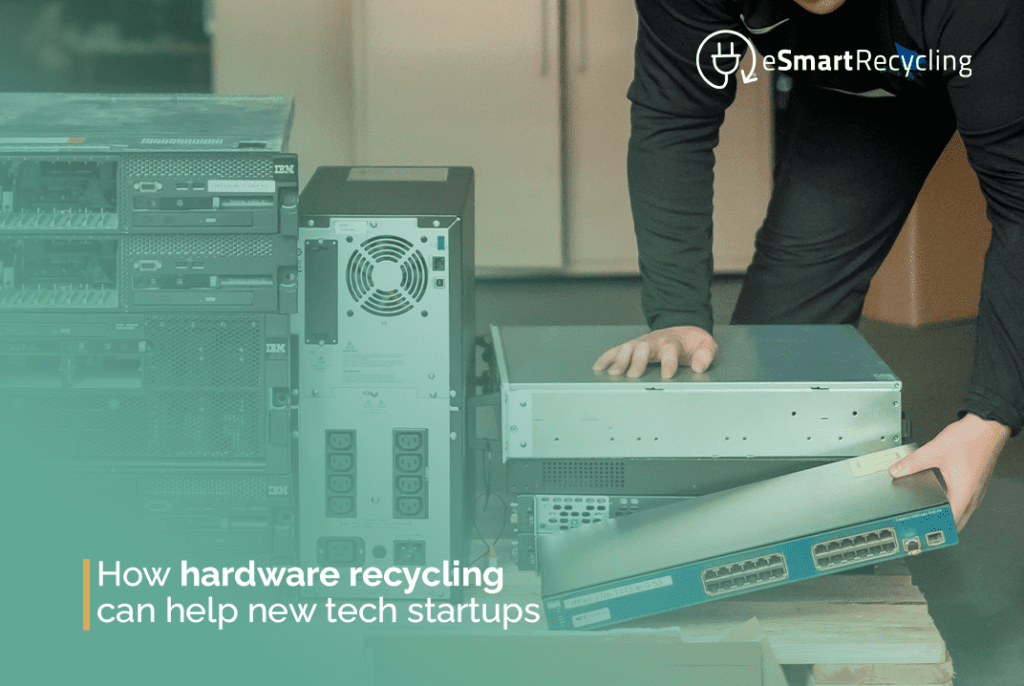
New tech startups face challenges not only in innovating and creating superior products but also in navigating the sometimes cumbersome infrastructure associated with hardware. With a surge of new and reinvented devices, the demand for new parts increases, resulting in more electronic waste.
It’s a global problem, but rising awareness and advocacy efforts have made strides toward reusing, refurbishing, and recycling old hardware components. How does hardware recycling help new tech startups? How does it support the broader mission of sustainability in tech development?
In this article, we will explore the benefits of hardware recycling for tech startups and ways to enable greater sustainability and innovation.
Many tech startups rely on open-source software, but operating with outdated hardware systems means updating and creating new applications is slow and costly. One of the main benefits associated with hardware recycling is cost savings. Instead of relying on conventional acquisition methods, tech startups can begin recycling old hardware components.
Recycling provides access to a plethora of parts and devices at a fraction of the cost of new hardware, thus saving startups significant amounts of money. Reusing electronics and technology also offers the opportunity to customize projects for a perfect fit. Often, companies use parts and products to find a final product far superior to what they would have achieved with new hardware components.
Another advantage of technology recycling is that it aligns with the desire and need for an eco-friendly business model. Startups with sustainability in mind can honor the earth by using materials that, if not reused or recycled, would end up in landfills.
It might not seem like much, but when companies reconsider their infrastructure and how they operate and procure hardware components, it can make a significant difference in reducing electronic waste.
Reusing technology helps combat the throwaway culture prevalent in today’s tech world. Operating with old infrastructures provides a foundation for startups to develop truly innovative new ideas.
Reusing old technologies also allows startups to begin development without taking on significant financial risk. Employees can work more comfortably with the assurance that old hardware provides a certain foundational security.
Additionally, recycling helps the tech sector conserve resources at another critical juncture. Without the reuse and recycling of tech components, the sector would continue needing to extract materials for new products. This practice of extraction and mining puts a strain on the Earth that can be avoided simply by reusing and recycling older materials.
Hardware recycling goes hand in hand with new tech startups. Recycling not only can be a cost-effective solution but also has the benefits of sustainability and a platform for increased ingenuity and creativity. If tech startups want to advance the mission of sustainable innovation, reusing and recycling old hardware components is a step in the right direction.
Recycling has the potential to save companies money, add value to their products or services, overcome limitations and barriers, and contribute to the global effort to reduce electronic waste. With the right tools, tech startups can overcome current challenges and harness the advantages of recycling.
Just remember, when building products or applications for the future, it’s always wise to think ahead and treat the future with respect.
As the world increasingly relies on electronic devices, the need to raise awareness about electronic recycling grows. Teaching children about electronic recycling is essential to ensure they grow up understanding the importance of keeping our planet free from electronic waste.
Educating children about electronic recycling should be part of their learning experience, helping to instill lifelong environmental awareness. This article explores ways to teach electronic recycling to children, the benefits of electronic recycling, and how it can be integrated into classrooms.
To start teaching children about electronic recycling, it’s important to help them understand what electronic waste is, how it’s created, and its environmental impact. Use age-appropriate articles, books, and videos to cover the topic. Discuss with children how household devices—like mobile phones, tablets, and gaming consoles—become waste when they’re no longer used.
Once children understand what electronic waste is, explain why it’s crucial to recycle it. Talk to them about how electronic devices are made from materials harmful to the environment and difficult to recycle. Explain that electronic recycling is essential to prevent toxic chemicals from these devices from reaching and damaging the air, water, and soil.
To help children grasp what electronic recycling is and how it works, be creative in your approach. Use simple examples, such as how glass and paper waste can be recycled into new items. Encouraging children to participate in recycling—like taking them to a local recycling center—can bring the concept to life.
Once children have a solid understanding of the importance and practice of electronic recycling, encourage them to incorporate positive recycling behaviors into their daily lives. Urge children to recycle all their old electronic devices to ensure products are disposed of safely. Additionally, helps them understand the importance of maintaining and repairing electronic devices to avoid the need for replacements.
Many schools are integrating electronic recycling into their curricula to help students understand the impact of electronic waste. There are a variety of educational resources available to help teachers introduce the topic and engage students in learning and practicing electronic recycling. From discussions and presentations to hands-on activities involving disassembling old devices, electronic recycling can be a fun and interesting educational experience for both teachers and students.
Teaching children about electronic recycling is a crucial step in ensuring the health and longevity of our planet. If children understand the impact of electronic waste and the importance of recycling electronics, they will be better equipped to make wise decisions regarding their own devices and to help protect the environment from the threat of toxic chemicals. With some creativity and the right resources, teaching electronic recycling to children can be an enjoyable and valuable experience for everyone involved.
If you’re concerned about the environmental impact of your electronic devices, you may have heard of nanotechnology. This emerging field of science has the potential to revolutionize our approach to electronic recycling. In this article, we’ll discuss the application of nanotechnology in electronic recycling and its advantages.
Nanotechnological recycling involves using nanoscale technology to break down and recycle electronic waste. Advances in science and technology have made it possible for nanotechnology to transform recycling methods. Some devices contain precious metals, like gold, which can be recovered and recycled after use. Nanotechnology offers an efficient solution for extracting these precious metals without harming the environment.
Nanotechnological recycling employs a method called leaching. Leaching is the process of extracting desired metals from electronic devices. Nanoscale technology is crucial for the leaching process, as metal oxide particles tend to bond together. By using nanoparticles such as functionalized carbon nanotubes, engineers can enhance extraction efficiency and reduce energy requirements.
Nanotechnological recycling has multiple benefits. A significant advantage of using nanoscale technology is the high extraction efficiency. Nanomaterials can extract more metals from electronic waste than conventional recycling methods. This leads to reduced energy consumption and a smaller environmental footprint. Another benefit is the reduced processing time. Major brands like Apple are already using the new leaching process in their recycling plants, enabling faster recycling compared to traditional methods.
Currently, scientists and engineers are experimenting with various types of nanomaterials to develop an improved recycling process. One of the most promising innovations is the use of artificial bacteria, which can increase metal extraction efficiency tenfold. Research is also being conducted on the use of biogenic nanomaterials to extract precious metals like gold and silver. The future of nanotechnological recycling looks promising, offering a more efficient, energy-saving, and environmentally friendly alternative to conventional methods.
Nanotechnological recycling uses nanoscale technology to extract precious metals from electronic waste. This technology boasts multiple advantages, such as high extraction efficiency and reduced energy consumption. Future advancements in nanomaterials will make the recycling process even more efficient and environmentally friendly. Major brands are already implementing this technology in their recycling plants, marking a step toward a greener future.
In our modern world, electronic waste, or e-waste, has become a significant environmental threat. A report published by the United Nations University, the Consumer Electronics Association, and its advocacy branch, the Consumer Technology Association, found that 44.7 million tons of e-waste were generated worldwide in 2017, an 8% increase from 2016.
While most people have heard about e-waste and its potential environmental impact, few know how to recycle it properly. This is where educating our younger generations becomes crucial in our efforts to combat the spread of e-waste.
The need to engage younger generations in the effort to address the growing e-waste crisis is evident. Younger generations are key to ensuring a sustainable future, and their knowledge and understanding can be decisive in combating e-waste issues before it’s too late. Young people are more likely to adapt to and adopt new technologies, meaning they will increasingly use and discard electronic devices. By fostering awareness of e-waste principles and actions, we can create a future where fewer electronic devices end up in landfills.
Here are some creative ways to engage younger generations in e-waste recycling:
One of the best ways to engage younger generations in e-waste recycling is by involving schools and educational institutions. They can play a crucial role in educating and motivating students from an early age. Schools can incorporate e-waste recycling and sustainability into projects, activities, and lesson plans. Some schools have even been reported to train students to start an e-waste recycling business to help spread awareness.
Technology can be a useful tool for educating younger generations about e-waste recycling. Apps can be created to alert and educate children about when their devices can be recycled, how to do it properly, and why e-waste recycling is important for the future.
One way to engage children is by creating a reward program for e-waste recycling. This can include prizes for students who collect the most e-waste or discounts on electronic devices for participating children. These programs can raise awareness about e-waste recycling and make it a fun activity.
Providing parents, teachers, and children with educational discussions and materials focused on e-waste recycling can greatly help in raising awareness and engagement. Educational materials can include learning activities, brochures, videos, and blog posts that discuss the importance of e-waste recycling and how to properly recycle electronic devices.
While schools and educational institutions can play a significant role in engaging younger generations in e-waste recycling, brands can also be valuable partners in this effort. Brands can use their platforms to educate the public about e-waste recycling while directly contributing to the cause. For example, brands can offer free e-waste recycling services and discounts for purchasing new devices, or even create partnerships with educational institutions to help support their initiatives.
The fight against the dangers of e-waste requires a joint effort from both younger generations and brands. Educating and engaging younger generations is crucial to creating a better, sustainable world for future generations.
Schools and educational institutions, along with the contributions of brands, can play a significant role in educating and motivating younger generations in e-waste recycling. We all have an important role to play in the fight against e-waste and now is the time to act and make a difference.
It is important to educate and engage younger generations in e-waste recycling to achieve a future change.
Each year, the rate of electronic waste becomes a growing concern among consumers and businesses. With increasing technological advancements and innovation comes an increase in electronic waste. With this in mind, it is important to develop new technologies and devices that are not only better for the environment but also more durable and sustainable. This is where eco-design comes into play: the idea of creating electronic devices that are easy to recycle and better for the environment in the long term.
Eco-design is becoming more common in the electronics industry because it offers many advantages. It helps reduce the production of electronic waste, lowers raw material consumption, increases resource efficiency, and reduces environmental impact. By producing electronic devices that use recycled materials, energy-saving components, and intelligent electronic designs, companies can create eco-friendly and cost-effective electronic devices.
Environmentally friendly design can also increase company profits. Many consumers are increasingly concerned about the environmental impact of electronic devices and are willing to pay more for sustainably produced gadgets. By creating eco-friendly devices, companies can attract more customers and stand out from the competition.
There are several ways to design more eco-friendly electronic devices. One of the most important considerations when designing electronics for recycling is using materials that are easily recyclable. This can include various materials such as bioplastics and aluminum, or lighter materials like composites. At the same time, it is also important to avoid using toxic substances and other hazardous materials. Many consumer electronics contain precious metals like gold, silver, and platinum. To increase sustainability and recycling potential, companies can consider using alternative materials like copper or ternary lithium, which are more recyclable.
The design of electronic devices also plays an important role in their sustainability. Devices should be designed to be easy to disassemble, contain minimal flame retardants, and be built using energy-efficient processes. Companies can also choose to implement energy-saving components in their electronic devices to reduce the overall environmental impact. For example, devices that use smaller LCD screens consuming less power to operate or low-power radiofrequency components can help reduce energy consumption.
When purchasing electronic devices, it is important to look for gadgets with eco-certification. Many companies offer eco-labeling or green certifications indicating that the device was produced sustainably. This can include the use of recycled materials in the production process, reduced energy consumption during production, and overall waste minimization. Companies like Apple, Dell, and Samsung offer eco-certified devices made with sustainable materials.
Consumers can also look for devices designed for easy disassembly and recycling. Devices with removable batteries, modular components, and labels indicating that the components are recyclable are ideal. This makes it easier to repair and recycle the device when it reaches the end of its life.
In the future, the design of electronic devices will continue to evolve to create gadgets that are better for the environment. Advances in material science are allowing companies to create lighter and more durable devices, reducing waste production. Companies are also exploring the use of advanced production techniques that reduce waste and improve energy efficiency.
Many companies are also starting to integrate eco-design into their business practices. This includes minimizing the use of packaging and using recyclable materials. Companies like Google and Samsung are also working to create closed-loop systems, allowing them to recover and recycle the materials used in the production of their electronic devices.
With the increase in electronic waste, companies need to develop electronic devices that are better for the environment. Eco-friendly design can help reduce the production of electronic waste, decrease resource consumption, and improve the overall durability of devices. Electronic devices should be made with easily recyclable parts and incorporate energy-saving components.
Both companies and consumers can also look for labeling indicating that devices were produced sustainably. In the coming years, advances in material science and production techniques will continue to drive the development of electronic devices that are better for the environment and more sustainable.
5G technology has taken the world by storm, opening up new possibilities for connectivity and convenience. With higher data speeds, 5G is revolutionizing how we connect our electronic devices and, in turn, how we use and recycle them. This next-generation technology has several advantages and some limitations regarding the generation and recycling of electronic products.
This article aims to shed light on the impact of 5G on the generation and recycling of electronic products and offer some insights into how the technology could transform the recycling industry.
5G technology represents the fifth generation of wireless technology. It is designed to deliver higher data speeds, lower latency, and more connected applications than its predecessors. 5G networks are more energy-efficient and can handle a greater number of devices simultaneously. For consumers, this means that smartphones and other connected devices will be more powerful, and applications like augmented reality and virtual reality will be faster and more reliable.
The powerful potential of 5G technology means that electronics manufacturers will produce new devices with even higher levels of connectivity and functionality. Devices such as smart home systems, security cameras, and medical wearables are likely to become even more popular, as will data-heavy devices like drones and smart cars. Traditional electronic devices like smartphones and tablets are also expected to be upgraded as 5G technology offers faster data speeds and capabilities.
However, as electronics become more advanced, they will be more challenging to recycle.
Recycling electronic devices is likely to become more difficult as 5G technology advances. Devices will be more intricate, with more components and materials that are difficult to recycle. This makes the need for a comprehensive and environmentally friendly recycling solution even more urgent. The increase in data transmission speeds will also mean that more data is stored on devices, making it more important for users to securely erase any stored data before recycling their devices.
While 5G technology presents some challenges for the recycling industry, it also offers an opportunity to improve the recycling of electronic products. Some experts believe that 5G can help enable the development of new recycling techniques and technologies. Advanced technologies like machine learning and artificial intelligence can help streamline the recycling process and make it more efficient.
Smart electronic devices can also be designed with recycling in mind, making it easier and more efficient to recover valuable materials.
5G technology is set to revolutionize how we connect our electronic devices and, in turn, how they are used and recycled. The increase in data transmission speeds and connectivity of 5G networks will lead to the production of a greater number of more complex devices. Therefore, all stakeholders in the electronics industry need to cooperate in developing better recycling solutions.
As 5G technology evolves, both the generation and recycling of electronic products will need to adapt accordingly to ensure that we can all enjoy the benefits of this new and powerful technology.
New tech startups face challenges not only in innovating and creating superior products but also in navigating the sometimes cumbersome infrastructure associated with hardware. With a surge of new and reinvented devices, the demand for new parts increases, resulting in more electronic waste.
It’s a global problem, but rising awareness and advocacy efforts have made strides toward reusing, refurbishing, and recycling old hardware components. How does hardware recycling help new tech startups? How does it support the broader mission of sustainability in tech development?
In this article, we will explore the benefits of hardware recycling for tech startups and ways to enable greater sustainability and innovation.
Many tech startups rely on open-source software, but operating with outdated hardware systems means updating and creating new applications is slow and costly. One of the main benefits associated with hardware recycling is cost savings. Instead of relying on conventional acquisition methods, tech startups can begin recycling old hardware components.
Recycling provides access to a plethora of parts and devices at a fraction of the cost of new hardware, thus saving startups significant amounts of money. Reusing electronics and technology also offers the opportunity to customize projects for a perfect fit. Often, companies use parts and products to find a final product far superior to what they would have achieved with new hardware components.
Another advantage of technology recycling is that it aligns with the desire and need for an eco-friendly business model. Startups with sustainability in mind can honor the earth by using materials that, if not reused or recycled, would end up in landfills.
It might not seem like much, but when companies reconsider their infrastructure and how they operate and procure hardware components, it can make a significant difference in reducing electronic waste.
Reusing technology helps combat the throwaway culture prevalent in today’s tech world. Operating with old infrastructures provides a foundation for startups to develop truly innovative new ideas.
Reusing old technologies also allows startups to begin development without taking on significant financial risk. Employees can work more comfortably with the assurance that old hardware provides a certain foundational security.
Additionally, recycling helps the tech sector conserve resources at another critical juncture. Without the reuse and recycling of tech components, the sector would continue needing to extract materials for new products. This practice of extraction and mining puts a strain on the Earth that can be avoided simply by reusing and recycling older materials.
Hardware recycling goes hand in hand with new tech startups. Recycling not only can be a cost-effective solution but also has the benefits of sustainability and a platform for increased ingenuity and creativity. If tech startups want to advance the mission of sustainable innovation, reusing and recycling old hardware components is a step in the right direction.
Recycling has the potential to save companies money, add value to their products or services, overcome limitations and barriers, and contribute to the global effort to reduce electronic waste. With the right tools, tech startups can overcome current challenges and harness the advantages of recycling.
Just remember, when building products or applications for the future, it’s always wise to think ahead and treat the future with respect.







If you want to know more about the different programs, partners, and overall cool things happening in the eSmart world, share your email with us, and Join the E-Revolution.


